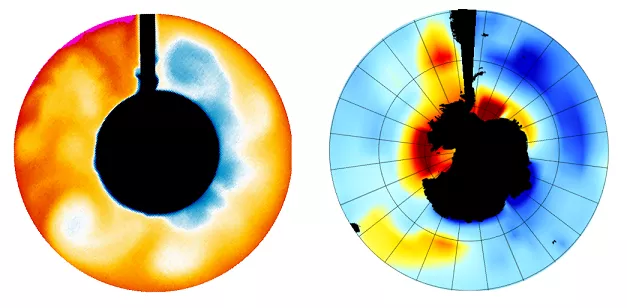Hungarian physicists and geologists have modelled the dynamics of one of the most dramatic changes in climate in the history of the Earth, the ancient global cooling that accompanied the glaciation of Antarctica, using a novel combination of laboratory experiments and computer simulations. Their findings, published in Scientific Reports, may shed new light on the cause and effect of an ancient climatic event that affected wildlife 34 million years ago, and thus contribute to understanding the dynamics of the rapid climate change that is taking place today.
The MTA-ELTE Theoretical Physics Research Group and MTA-MTM-ELTE Research Group for Paleontology, both belonging to the Eötvös Loránd Research Network (ELKH), and the Konkoly Thege Miklós Astronomical Institute of the ELKH Research Centre for Astronomy and Earth Sciences (CSFK), the ELKH Institute of Earth Physics and Space Science (FI) and the Department of General and Applied Geology of ELTE investigated the adequacy of the widely accepted textbook explanation of the so-called Eocene-Oligocene transition. The opening of the Drake Passage, the land bridge between South America and the Antarctic Peninsula, played a major role in the history of the event, creating the largest ocean current on the planet, the circumpolar current around Antarctica. The traditional interpretation is that this water cycle isolated the Antarctic from the ocean currents carrying warmth from the tropics, causing the Southern Ocean and Antarctic temperatures to drop until the permanent ice sheet finally appeared.

The researchers studied a radically simplified model of the Southern Ocean in experiments at the Kármán Laboratory of the ELTE Institute of Physics, the only dedicated climate research facility in Central Europe, and at the Brandenburg University of Technology in Cottbus, Germany. The laboratory setup is a cylindrically symmetrical tank rotated on its axis and filled with water, in which the 'Arctic equator' temperature difference is provided by heating and cooling the side walls. In the model, a removable bulkhead represented the closed Drake Passage, and high-precision infrared sensors were used to monitor the redistribution of the model ocean temperature after the barrier was removed. Surprisingly, the experiments found that the 'sea surface' temperature values did not decrease; instead, they increased in all cases after the opening of the passage, contradicting the textbook argument for the cooling effect of the onset of the circulation.

In order to resolve the discrepancy between the experimental results and the data from historical temperature reconstructions, the team turned to a global computer climate model including the ocean water cycle, which allowed them to virtually 'close' the Drake Passage, i.e. to redraw the contours of the continents. The PlaSim (Planet Simulator) software package also allowed equations describing the formation of sea ice to be removed from the model. The results showed that if the simulation allows for the formation of ocean ice, which has a significant reflective and cooling effect, the opening of the Drake Passage will indeed lead to a global temperature decrease, consistent with the Earth's history. However, when ice is blocked in the program, there is a slight increase in temperature, as in the ice-free laboratory experiment.
The results will contribute to a better understanding of the complex cause and effect of the abrupt climate change of 34 million years ago. The research shows that the traditional argument claiming that the rearrangement of the ocean circulation system alone could have explained the sudden cooling of our planet, which neglects the secondary reflective effect of ice formation, is not valid on its own. Our understanding of the planet's interconnected oceanic and atmospheric processes in the past can also be used to predict the alarming rate of climate change today.